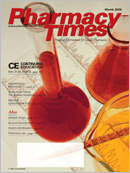Publication
Article
Pharmacy Times
Management of Acute Heart Failure
Author(s):
With the aging of the populationand improvement inmedical care, an increasednumber of people are surviving anacute myocardial infarction (MI) andsubsequently developing heart failure(HF). There also has been an increasingnumber of hospitalizations for acuteheart failure (AHF). A Task Force forAHF Guidelines was formed by theCommittee for Practice Guidelines ofthe European Society of Cardiology.The following is a brief summary of thetask force's recommendations formedications used in the managementof patients with AHF.1 The Classes ofRecommendations and Levels of Evidenceused in these guidelines arecomparable to what is commonly usedby the American College of Cardiologyand the American Heart Association.
Definitions
Classes of Recommendations
- Class I: Evidence or general agreementthat a given diagnostic procedureor treatment is beneficial, useful,and effective
- Class II: Conflicting evidence and/ora divergence of opinion about theusefulness/efficacy of the treatment Class IIa: Weight of evidence/opinion in favor of usefulness/efficacy Class IIb: Usefulness/efficacyless well-established by evidence/opinion
- Class III: Evidence or general agreementthat the treatment is not useful/effective and in some cases maybe harmful
Levels of Evidence
- A: Data derived from multiple randomizedclinical trials or metaanalyses
- B: Data derived from a single randomizedclinical trial or large nonrandomizedstudies
- C: Consensus of opinion of theexperts and/or small studies; retrospectivestudies and registries
Class I Recommendations
- Nitrates: Relieve pulmonary congestionbut do not reduce strokevolume or increase myocardial oxygendemand (Level of evidence B)
- Sodium Nitroprusside: Recommendedin patients with severe HFwith predominantly increased afterload,such as in hypertensive HF(Level of evidence C)
- Diuretics: Should be administered topatients with AHF who have symptomsrelated to fluid retention (Levelof evidence B)
- Life-threatening Arrhythmias: AHFpatients in ventricular fibrillation orventricular tachycardia should beimmediately cardioverted. Amiodaroneand beta-blockers can help preventsubsequent arrhythmias. (Levelof evidence A)
Class IIa Recommendations
- Beta-blockers: Should be initiatedearly in patients with acute MI whostabilize after developing AHF (Levelof evidence C)
- Inotropic Agents: Should be usedwhen there is peripheral hypoperfusionrefractory to diuretics andvasodilators at optimal doses (Levelof evidence C)
- Dobutamine: Indicated when thereis peripheral hypoperfusion refractoryto vasodilators and diuretics atoptimal doses (Level of evidence C)
- Type III Phosphodiesterase Inhibitors:Preferred to dobutamine inpatients taking beta-blockers (Levelof evidence C)
- Levosimendan: A drug approved inEurope that is indicated in patientswith symptomatic low cardiac outputand AHF due to systolic dysfunctionwithout severe hypotension (Level ofevidence B)
- Metabolic Support: Using high-doseglucose, insulin, and potassium is notrecommended for most patients atthis point. (Level of evidence A)
- Management of Bradycardia: Itshould be treated with atropine and atemporary pacemaker if necessary.(Level of evidence C)
- Control of Ventricular Rate:Important in patients with AHF andatrial fibrillation, especially in patientswith diastolic dysfunction (Level ofevidence A)
Class IIb Recommendations
- Morphine: Should be used in theearly stage of treatment of severeAHF, especially when the patient isexperiencing restlessness and dyspnea(Level of evidence B)
- Intravenous (IV) Loop Diuretics:Preferred in patients with AHF.Doses should be titrated for reliefof symptoms. (Level of evidence C)
- Beta-blockers: Should be usedcautiously in patients with overtAHF and more than basal pulmonaryrales. In such patients withongoing ischemia and tachycardia,however, IV metoprolol may beused. (Level of evidence C)
- Dopamine: May be used as aninotrope (>2 mcg/kg/min) in AHFwith hypotension. Low doses ofdopamine (2-3 mcg/kg/min) maybe used to optimize renal bloodflow and diuresis. If no response isobserved, however, therapy shouldbe stopped. (Level of evidence C)
- Type III Phosphodiesterase Inhibitors:Indicated when there isperipheral hypoperfusion refractoryto optimal doses of vasodilatorsand diuretics and preserved systemicblood pressure (Level of evidenceC)
- Potassium and MagnesiumLevels: Should be normalized, especiallyin patients with ventriculararrhythmia (Level of evidence A)
Other Comments
- Angiotensin-converting Enzyme(ACE) Inhibitors: IV ACE inhibitorsshould be avoided in AHF, but longtermuse of oral ACE inhibitors hasbeen associated with reduction inmortality in HF patients
- Verapamil and Diltiazem: Should beavoided in AHF because they mayworsen HF and result in third-degreeatrioventricular block
- Anticoagulation: Evidence is lackingregarding the benefit of anticoagulationin AHF
- Vasodilators: Typically first-line therapyif signs and symptoms of hypoperfusionare accompanied by adequateblood pressure and signs ofpulmonary congestion with lowdiuresis
- Diuretic Resistance: May be managedin a number of ways:Restricting sodium and waterintakeReplacing volume if necessaryUsing IV diureticsIncreasing the dose or frequencyof administration of diureticsCombining therapy with thiazides,spironolactone, dopamine, or dobutamineReducing thedose of anACE in-hibitorUltrafiltrationor dialysis if responseis suboptimalto abovestrategies
- Dobutamine:Should be used toincrease cardiacoutput. Doses ofdobutamine oftenneed to be increasedin thepresence of betablockers.Effectsof dobutamine areadditive with phosphodiesteraseinhibitors.Dobutaminealso is associatedwith increasedrisk ofarrhythmia.
- CardiacGlycosides:Should generallynot be used inAHF, especiallyfollowing MI, because they havebeen associated with a possibleincrease in life-threatening proarrhythmicevents. They may be usefulin AHF, however, for tachycardiawhen other agents, such as betablockers,have proven ineffective.
- Nesiritide: Because it is not currentlyavailable on some European markets,nesiritide was not integrated intothese recommendations. The guidelinescomment, however, on its mechanismof action, dosing, and main sideeffect of hypotension. Nesiritide hasnot been shown to have a mortalitybenefit over other managementstrategies.
Dr. Tafreshi is an associate professorof pharmacy and medicine and directorof the Cardiology PharmacyPractice Residency at MidwesternUniversity, College of Pharmacy—Glendale (MWU-CPG), Glendale, Ariz.At the time of the completion of thisarticle, Dr. Irving was a senior pharmacystudent at MWU-CPG. Dr. Ng is aclinical pharmacist at Banner EstrellaMedical Center in Phoenix, Ariz.
For a list of references, send astamped, self-addressed envelope to:References Department, Attn. A. Stahl,Pharmacy Times, 241 Forsgate Drive,Jamesburg, NJ 08831; or send an e-mailrequest to: [email protected].







